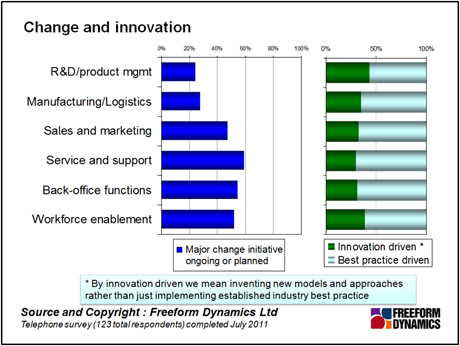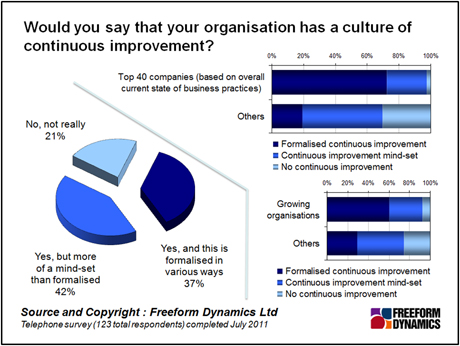Marketing people and management consultants love the words ‘transformation’ and ‘innovation’. As you listen to the rhetoric of those trying to sell you stuff, you could get the impression that if the change or investment you are planning is not transformative or innovative then it represents some kind of cop out or compromise. In a fast moving competitive environment, the notion is that you must shake things up radically to make a difference, which of course is going to require expensive advice from people in suits and/or significant spending on new technology.
Recent research from Freeform Dynamics, however, suggests that CIOs would be advised to adopt a more inclusive view when considering how best to support business change. When two groups of important business stakeholders – finance and operations executives – were interviewed across 123 large European enterprises, the true nature of business change became very apparent.
Firstly, when we looked at major change initiatives ongoing or planned across key functional areas, it was clear that the majority of these were not transformative but ‘optimising’ in nature, aimed at streamlining existing models and processes (Figure 1).

Figure 1
If we put the PowerPoint presentations of the supplier community to one side, this is not surprising. While there are occasions when a part of the business needs a complete redesign, the fundamentals of business models and processes do not require changing that often. What frequently does need attention, however, is the way they are executed.
Merger and acquisition activity, for example, can easily lead to different parts of the business doing essentially the same things in different ways using different systems. The same can happen as lines of business diversify and the same or similar processes emerge organically across different departments or divisions. Projects aimed at streamlining operations under such circumstances are often not genuinely transformational, but obviously still lead to significant performance benefits.
Turning to the role of technology, it has become trendy to point out that automating poor process means you end up just doing the wrong things more quickly. But let’s not lose sight of the fact that automating *good* existing processes that simply happen to involve in a lot of manual activity can often pay back handsomely. As technology evolves, opportunities arise to optimise as well as transform, and both are important. The trick is to work out when to apply which approach.
Just as transformation is not always appropriate, neither is innovation, and again this is evident from the mix of change activity declared by business executives (Figure 2).

Figure 2
If you are innovating for no good reason you can waste time and end up with suboptimal models or processes that actually hurt or hold back the business. The most common way in which this manifests itself is when teams involved in change programmes or technology implementation projects reinvent the wheel. Sometimes this happens as a result of ignorance, e.g. when those on the project don’t know that the metaphorical wheel already exists. This is why the research phase of any project is so important, the aim being to identify how the same or similar requirements have been met elsewhere in the past – not just in your organisation, but across your peers, competitors and even other industries.
But misguided innovation can also come about because of the ‘not invented here syndrome’. One of the most obvious examples of this is the customisation of packaged applications to implement ‘non-differentiating’ business processes in an alternative manner, rather than adopting proven best practice encapsulated in the standard solution.
The motives here are often to preserve past innovations that represent ‘organisational heritage’ even though they are no longer relevant because the market, business or technology has moved on. Then there are practices that have simply evolved over the generations to the point where they are institutionalised even though no one can remember why things ended up being done that way. Moving away from these can be disruptive, but it’s often better to migrate to more efficient and effective industry standard approach. This underlines the difference between transformation and innovation. Sometimes, for example, it makes absolute sense to transform a business process in a non-innovative manner.
Beyond major change initiatives of the kind we have been discussing, enabling a more continuous approach to business improvement is a trait that most high-achieving organisations have in common (Figure 3)

Figure 3
Clearly an ability to flex and optimise business operations on demand is an important contributor to driving consistent ongoing performance.
Against this background, and considering the high level of IT dependency that exists in pretty much any modern business, emerging technologies and ideas designed to create a more flexible and agile IT environment come into sharp focus. Advances in areas such as service oriented architecture (SOA), more coherent and flexible data management, pervasive access to systems, and various forms of cloud computing, are particularly relevant here.
But embracing such technologies to enable continuous improvement and minimise the need for disruptive business change programmes can sometimes translate to quite a bit of change within the IT department. This challenges another mythical dependency, this time between business transformation and IT transformation. Indeed the ideal situation is one in which even major business change can be implemented where necessary without significant IT re-engineering.
This may sound like a pipe dream in today’s environment where IT activity too often defines the critical path for business change initiatives, but it’s something to bear in mind as you are putting together your IT budgets for 2012. If all major IT investments are aligned with big business projects, with nothing left over to invest in agile core infrastructure and process, that should raise a flag about whether you strategy really is going to move things in the right direction.
CLICK HERE TO VIEW ORIGINAL PUBLISHED ON
